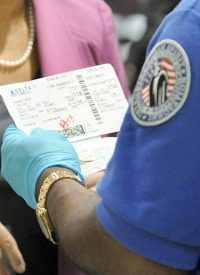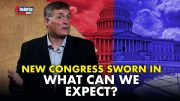
Instead of focusing on security, the agency has become “an enormous, inflexible and distracted bureaucracy, more concerned with human resource management and consolidating power,” according to the investigation released on November 16. “Today, TSA's screening policies are based in theatrics. They are typical, bureaucratic responses to failed security policies meant to assuage the concerns of the traveling public.”
The Joint Majority Staff Report entitled "A Decade Later: A Call for TSA Reform" sharply criticized the widespread waste and inefficiency that is rife throughout the “bloated bureaucracy.” The agency also suffers from a lack of administrative competency, investigators found.
According to the report, TSA has more than 65,000 employees. That means it has more personnel than the Departments of Labor, Energy, Education, Housing and Urban Development, and State — combined. And its own “classified” performance results “do not reflect a good return on this taxpayer investment,” investigators said.
Yet somehow, the agency keeps growing. “TSA is a top-heavy bureaucracy with 3,986 headquarters personnel and 9,656 administrative staff in the field,” the report noted, with U.S. representatives saying the D.C. headquarters staff earn more than $100,000 a year on average. “Since 2001, TSA staff has grown from 16,500 to over 65,000, a near 400% increase.”
Despite the overwhelming TSA presence at U.S. airports, and all of the groping and security theater, more than 25,000 security breaches have occurred in the last 10 years. "The ability of TSA screeners to stop prohibited items from being carried through the sterile areas of the airports fared no better than the performance of screeners prior to September 11, 2001," former Department of Homeland Security (DHS) Inspector General Richard Skinner was quoted as saying in the report.
The investigation also concluded that despite wasting almost a billion dollars so far on the TSA’s so-called “behavior detection program,” not a single terrorist has been caught. Even more alarming: At least 17 known terrorists traveled unmolested in the area of two dozen times through airports where TSA employs its “behavior detection officers.” None of the terrorists were even stopped.
So, to compensate for its failure to catch any real terrorists, the program expanded — without congressional approval — to seek out petty criminals as well. TSA bureaucrats managed to find more than 1,000 people to arrest on drug charges, immigration violations, and other crimes.
But not a single person identified by TSA bureaucrats has been charged with a terror-related offense so far. Indeed, “passengers and crew offer our first and most effective line of defense,” the report noted.
But throwing away money seems to be a defining characteristic of the unwieldy agency. “TSA's personnel operations provide another example of the waste and mismanagement that is rife within the agency,” investigators said, citing numerous examples.
The agency, for instance, ignored its own findings that private contractors were less costly and more effective than government bureaucrats. And TSA union bosses fought to kill the private-screener program to save federal jobs — despite legislation instructing the agency to implement it.
“TSA has continuously thwarted the adoption of the [Screening Partnership Program] and has a history of intimidating airport operators that express an interest in participating in the SPP," noted the report, saying that in some instances agency officials used scare tactics and even lobbied against the program to bring in private firms.
“Almost all western countries have evolved their airport screening systems to meet current aviation threats through federal oversight of private contract screeners,” the report said, explaining that a few former communist nations like Romania and Bulgaria that still have government-operated airport security. “The U.S. must also evolve to provide the most effective transportation security system at the most reasonable cost to the taxpayer.”
The naked-body scanners that caused such an uproar among passengers were probably a waste of money, too. Not only would they not have identified the explosives used by the so-called “underwear bomber,” the machines even failed to identify a concealed pistol in the TSA’s own internal tests.
But even if the scanners were effective, “passengers are easily able to bypass this technology by choosing a screening lane without these AIT machines in use,” the report noted. “TSA has wasted hundreds of millions of dollars in taxpayer funds on failed solutions to securing commercial aviation, ignoring internal protocols to prevent such waste and adopting technologies that have repeatedly failed TSA's own covert tests.”
Among the specific problems identified in the report were a “flawed” leadership structure, the “bloated administration and bureaucracy,” and more. But instead of recommending the dismantling of the “bloated bureaucracy,” the report offers a series of fairly minor suggestions.
Among the recommendations made by investigators were expanding the use of private-contractors at airports, shifting to risk-based procedures, setting better performance standards, slashing the number of “administrators,” expanding operations overseas, publicizing performance results after an appropriate time delay, and hiring outside experts to review the agency. Other suggestions that may prove more controversial included the development of “biometric standards” to screen “trusted passengers” and crew, as well as giving the agency more independence from the Department of “Homeland Security.”
Congressmen on the relevant committees — many of whom helped to create the agency during the Bush administration — had harsh words for the TSA after the report was released. And legislation to “reform” the agency will be introduced soon.
“Americans have spent nearly $60 billion, and they are no safer today than they were before 9/11. We need to make travel safe in America, and right now it’s not,” complained Rep. Paul Broun (R-Ga.), noting that terrorists could “very easily” put a bomb on a plane. “TSA has not prevented any attacks. It’s just been very fortunate that we’ve had no attacks.”
Chairman John Mica (R-Fla.) of the House Transportation and Infrastructure Committee was upset, too. "After countless expensive detours, it is time for TSA to refocus its mission based on risk and develop common sense security protocols," Rep. Mica said. “We never intended to have TSA grow into this massive bureaucracy.”
Predictably, however, a taxpayer-funded apologist for the bureaucracy was not pleased with the stinging criticism contained in the report. “At a time when our country’s aviation system is safer, stronger and more secure than it was 10 years ago, this report is an unfortunate disservice to the dedicated men and women of TSA who are on the front lines every day protecting the traveling public,” TSA spokesman Greg Soule was quoted as claiming in the Washington Post. “TSA has developed a highly trained federal workforce that has safely screened over 5 billion passengers and established a multilayered security system reaching from curb to cockpit. ”
In reality, the TSA has consumed about $57 billion since its creation — the equivalent of the entire GDP of Vermont and North Dakota combined. And in return, as the report shows, taxpayers have been groped and scanned — all “theatrics” apparently — by an incompetent bureaucracy that has failed to catch or stop one single terrorist.
Related articles:
TSA Searches Expand as Opposition Mounts
TSA Stages Highway Searches to Show Its Tennessee Valley Authority
TSA Downplayed Cancer Concerns in Deploying X-ray Scanners
Sunshine State TSA Screener Seen Stealing From Suitcases
Getting Rich from the TSA Naked-Body Scanners
A Tennessee Trucker and the TSA
TSA Records: Some Scanners Emit Ten Times Expected Radiation
Woman Accuses TSA Agent of Molestation at Airport
Anti-TSA Groping Bill Fails in Texas
Feds "Mess With Texas," Attack Anti-TSA Bill
Texas Officials Groped by TSA as Anti-Groping Bill Makes Comeback
Passengers: Feds Orchestrated “Underwear Bomber” Plot to Advance War on Terror
Whole Body Scanners: Would They Have Detected the Detroit Bomb?
Photo: AP Images



